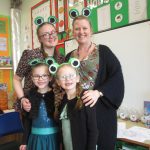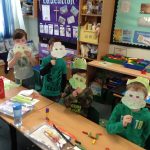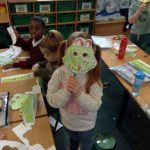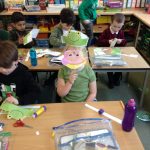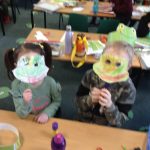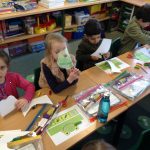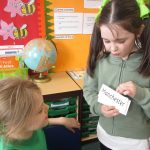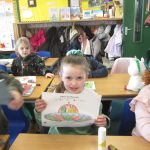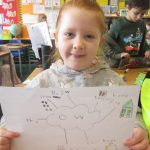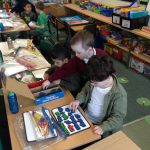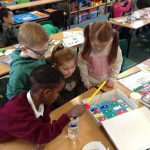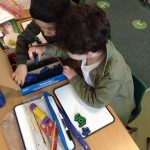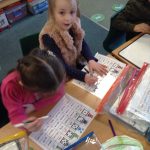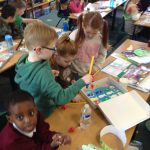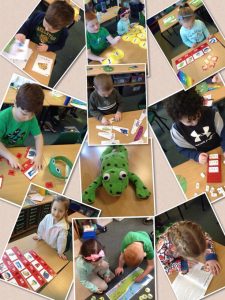Phonics Lead – Miss Sargent
Vision
St Anne (Stanley) CE School is a safe, welcoming and inclusive environment where we strive to ensure that all children become successful, fluent readers by the end of Key Stage One and believe this is achievable through a combination of strong, high quality, discrete phonics teaching combined with a whole language approach that promotes a ‘Reading for Pleasure’ culture.
Intent
At St Anne (Stanley) we provide a high quality Phonics curriculum, underpinned by our school values, that is designed to be inspiring, inclusive and practical to ensure that every child is engaged and supported to help them achieve their fullest potential. We belief that all children should get the best teaching possible in this crucial area so we deliver the important skills and knowledge of phonics through a combination of strong, high quality, discrete phonics teaching combined with a whole language approach to ensure all children achieve and succeed to their highest potential. This approach has been shown to provide a quick and efficient way for most young children to learn to read and write words on the page, fluently and accurately and we endeavour for children to develop this skill so that it becomes automatic. ‘The ability to read is the key to educational achievement‘ and our Read Write Inc (EYFS and KS1) and Oxford Reading Tree (KS2) reading schemes fully support our phonics programme. ‘Without a basic foundation in literacy, children cannot gain access to a rich and diverse curriculum. Poor literacy limits opportunities not only at school, but throughout life, both economically and in terms of a wider enjoyment and appreciation of the written word’. (Education and Skills Committee).
Implementation
To ensure that each child develops the skills and knowledge to be able to read and write in St Anne (Stanley), we use a structured phonics programme called Read Write Inc. Phonics.
‘Read Write Inc. Phonics teaches children to read accurately and fluently with good comprehension. They learn to form each letter, spell correctly, and compose their ideas step-by-step. Children learn the English alphabetic code: first they learn one way to read the 40+ sounds and blend these sounds into words, then learn to read the same sounds with alternative graphemes. They experience success from the very beginning. Lively phonic books are closely matched to their increasing knowledge of phonics and ‘tricky’ words and, as children re-read the stories, their fluency increases. Along with a thought-provoking introduction, prompts for thinking out loud and discussion, children are helped to read with a storyteller’s voice.
The children write every day, rehearsing out loud what they want to say, before spelling the words using the graphemes and ‘tricky’ words they know. They practice handwriting every day: sitting at a table comfortably, they learn correct letter formation and how to join letters speedily and legibly. Children’s composition (ideas, vocabulary and grammar) is developed by drawing on their own experiences and talking about the stories they read‘ (Ruth Miskin)
Read, Write, Inc. Lessons
https://www.youtube.com/watch?v=MbWIujM1WGM
We start Phonics in Nursery by giving them lots of opportunities to develop familiarity with stories, nursery rhymes, poems and songs. We want to encourage all our children to love books and reading and when children are read stories aloud to them, it encourages a sense of comfort and love with reading. Every class in our school has a dedicated reading area which provides children with the opportunity to read their choice of books in a safe, quiet and comfortable space.
In Nursery, we talk a lot to children and ask questions to encourage a wide vocabulary. We are able to do this throughout the day in our planned and child initiated activities, through role play, building sentences orally, making up stories and talking about what the children have done or created.
As the children move through Nursery and are getting ready to start Reception, we begin to teach the children to read and write the first set of sounds.
https://www.youtube.com/watch?v=KUbrJPAt65g
Reading
We begin by teaching the children set 1 sounds. Children can start blending sounds into words as soon as they know a small group of letters well. Once the children have been taught the first 5 sounds (m, a, s, d, t), they are then taught assisted blending using the sounds that they know. During lessons children are taught to hear sounds and blend them together in sequence to make a word. We start with blending oral sounds, then progress to reading the letters and blending them together to read the word.
Order of teaching sounds
In Read Write Inc phonics the individual sounds are called ‘speed sounds’ – because we want your child to read them effortlessly. Set 1 sounds are the single letter sounds and set 1 special friend sounds. They are taught in the following order;
m, a, s, d, t, i, n, p, g, o, c, k, u, b, f, e, l, h, r, j, v, y, w, th, z, sh, ch, qu, x, ng, nk.
There are 12 Set 2 ‘speed sounds’ that are made up of two or three letters which represent just one sound, e.g. ay as in play, ee as in tree and igh as in high. These are ‘special friend’ sounds.
When children are taught Set 2 sounds they will learn:
- a simple picture prompt linked to the sound
- a short phrase to say e.g. may I play
- the letters that represent a sound (special friends) e.g. ay
Each sound has a list of green words linked to it, so that the children have the opportunity to sound out and blend words containing the new sound they have been taught, for example, s-p-r-ay = spray.
When learning Set 3 speed sounds the children will be taught alternative sounds/graphemes, e.g. ee as in tree and ea as in tea.
Nonsense words (Alien words)
As children build up their knowledge of sounds they are able to apply their decoding skills to any unfamiliar word, whether it be real or nonsense. During lessons each day children will practice their decoding skills by sounding out nonsense words. Children are unable to rely on existing knowledge of real words, and instead have to use their letter-sound knowledge. This is an important part of the Phonics Screening Check that the children complete at the end of year 1.
Learning to blend and Ditty Books
As soon as children have been taught a few initial letter sounds they begin to learn to blend the sounds together to read real words in a Word Time session. Each word time session involves oral blending of known sounds before they are shown the words written down on green cards. Children practice Fred talking the words until they become able to read them on sight. Ditty lessons follow on from this where children who are becoming excellent at reading single words are introduced to reading short sentences. Once children are confident reading the short sentences they are challenged to use their developing phonic knowledge to write a sentence.
Storybook Lessons
After ditty books, the next stage is storybooks. These books are closely matched to their developing phonic knowledge. The storybooks consist of green words linked to the sounds that they have been learning, red words and challenge words to extend the children’s vocabulary. After children have practiced these words individually they are prepared to see them in context in the story.
Comprehension activities, partner discussion and writing activities based on the book, follow on from reading.
Reading into writing
Each story book follows a three or five day plan.
Writing activities include;
- ‘Hold a sentence’ which encourages the children to remember a whole sentence while focusing on spelling and punctuation
- ‘Edit a sentence’ which allows the children to critique a sentence using their knowledge of spelling, punctuation and grammar.
Impact
At St Anne (Stanley) the purpose of monitoring and evaluation activities is to raise the overall quality of teaching and levels of pupil attainment. The quality of teaching and learning throughout the school is consistently monitored through book scrutiny, lesson observations, learning walks and pupil voice. In Phonics, children are assessed half termly by the Reading Leader although class teachers will assess throughout the lessons. This ensures that children are placed in groups appropriate for their learning so that every child succeeds.
To guarantee that progress is made for all children in Phonics, all staff have been trained in Read Write Inc Phonics and the Reading Leader is able to coach and implement training sessions to support them in their journey. All staff have access to www.ruthmiskin.com where they can access videos to support their CPD. This ensures that children are fully supported by all staff and have access to a full phonics lesson daily.
We follow the Read Write Inc Progression Map across our school and know what to expect our children at St Anne (Stanley) to achieve in each year group in phonics and early reading.
 My name is Miss Sargent and I work in St Anne (Stanley). I absolutely love working in this school. The children and staff are all amazing and I love seeing their smiles every day.
My name is Miss Sargent and I work in St Anne (Stanley). I absolutely love working in this school. The children and staff are all amazing and I love seeing their smiles every day.
I have been teaching in Year 1 since starting at St Anne (Stanley) and love this age group. I have previously worked in Nursery and Reception in different schools and from my experience I know how important it is to have exciting lessons so that the children learn new things every single day.
I am responsible for leading Phonics in our school and it is my favourite subject. I think Phonics is so important because without it we would struggle with our reading and writing in every subject. However, we make sure we have lots of fun learning Phonics, by doing different types of activities and games that keep us active and involved in our learning.
At St Anne (Stanley) we know that Phonics is a life skill. We want children to understand that reading and writing is something that they will use in every area of their lives and that Phonics is just the beginning of this. We have worked hard to ensure that Phonics is taught to a high standard in every classroom. Teachers, TAs, and all other staff model how Phonics impacts life by talking about how we use reading and writing skills at home, when out shopping, cooking, travelling and even when doing our favourite sports for example.
We use a scheme called Read Write Inc. Phonics. This ensures that every child is given a strong, high quality, structured, daily lesson in Nursery, Reception, Year 1 and 2.
I understand how important it is for parents to be able to help their child/children at home and that Phonics can be a difficult concept for them. I have been able to provide Nursery and Reception parents, alongside Mrs Riley our Early Years Coordinator, with information sessions about how we teach Phonics in St Anne (Stanley). In Year 1, children undertake a Phonic Screening Check. I also provided an information session about this and the staff provide packs of activities that can be used at home. Our website has videos and information about Phonics that all can access.
In school, we have to ensure that children are reading at a level that is appropriate for them and to do this we regularly assess their phonic knowledge and recognition of key words, from Reception upwards. We provide home reading books that are linked to their phonic understanding as well as books that children can read for pleasure. As a school, we think that it is so important to have a love of reading so we want to ensure every child gets the opportunity to participate with enjoyable, exciting books that they can read independently.
I enjoy reading and read every night. My favourite authors are Stephen King and James Patterson but I absolutely love reading books, like the Gruffalo or Class Two at the zoo, to the children every day in school. It is such an important skill to have and we aim to have all children at St Anne (Stanley) reading by the time they leave and head off to pastures new.
Celebrating Phonics
We decided to celebrate our achievements of Phonics that we had been doing at home and in school. We held a Fred Phonics Day and everyone dressed in green to be just like Fred Frog. We played lots of Phonics games, did Phonics activities and Cheryl our cook even made us some green crispy cakes for our snack. We had a great day
Parents
We want our parents to be involved in the children’s learning of Phonics at home as well as in school. Have a look at the phonics booklets to help you understand how phonics is taught in St Anne (Stanley).
If you need these in another language please ask a member of staff
RWI set 2 sounds Chinese (Hong Kong)
We have attached some videos that may support you below. Please take a look at them.
https://www.youtube.com/embed/kfmCcxzzMcI
This is a video to show you how we teach children (and adults) how to pronounce the phonemes (sounds). Pronouncing the phonemes correctly, supports the children in their reading and writing from the beginning of their early reading journey.
Once children know the phonemes (sounds) they can start to blend them together to say and read words. here is a video showing you how we do this
Support for Phonics
If you would like to support your child further at home, here are some websites and Apps that you could use.
Websites
https://www.ruthmiskin.com/en/find-out-more/parents/
https://home.oxfordowl.co.uk/reading/reading-schemes-oxford-levels/read-write-inc-phonics-guide/
http://www.teachyourmonstertoread.com
https://www.youtube.com/user/breakthruchris
http://www.ictgames.com/literacy.html
http://www.bigbrownbear.co.uk/magneticletters
http://www.phonicsinternational.com/hear_the_sounds/hear_the_sounds_1.htm
https://www.youtube.com/channel/UC_qs3c0ehDvZkbiEbOj6Drg
Apps
https://apps.apple.com/gb/app/jolly-phonics-lessons/id1149029299
https://readingeggs.co.uk/apps/eggy-phonics/
https://www.readwithphonics.com/app
https://www.nessy.com/uk/apps/
Do you have any questions or queries about phonics in St Anne (Stanley)? Please speak to Miss Sargent (Phonics Lead) or your child’s class teacher.


